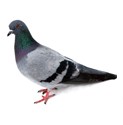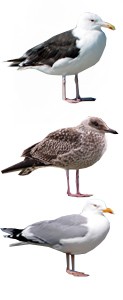Pest Birds
Feral Pigeon

Feral pigeons also called city doves, city pigeons, or street pigeons, are derived from domestic pigeons that have returned to the wild.
Feral pigeons have become adapted to urban life, and are abundant in towns and cities throughout much of the world.
They nest on ledges and building voids and are very opportunistic feeders with a varied diet ranging from seeds and nuts from bird tables to insects and discarded take away food.
They can transmit to human’s diseases such as salmonella, e coli and ornithosis, sometimes called “pigeon fanciers lung”
There are various control measures available and the method deployed is dependent on the situation.
Seagulls

There are 3 main pest species of gulls identified as pests in the UK
1. The Greater Black Backed Gull
2. The Lesser Black Backed Gull
3. Herring Gull
Seagulls have traditionally been coastal birds, but increases in the number of landfill and refuse tips have led to a marked increase in gull populations inland.
This habit of feeding on landfill and refuse tips has led to gulls being implicated in the transmission of a host of diseases such as salmonella and e coli.
Seagulls are increasingly using flat roofs and even roofs of domestic dwellings as nesting sites.
The birds will form breeding pairs in early spring and will remain together throughout the breeding period March to September, dependent on conditions and will usually only raise one clutch per year.
It is during the breeding season that gulls present the greatest danger to the general public.
Their habit of breeding on roofs leads to building fabric damage, particularly to flat roof coverings and window surrounds.
Gulls will aggressively defend their nests and chicks from any perceived threat and can regularly be seen dive bombing on humans walking past.
They will also defecate and vomit on any perceived threat as a further deterrent.





